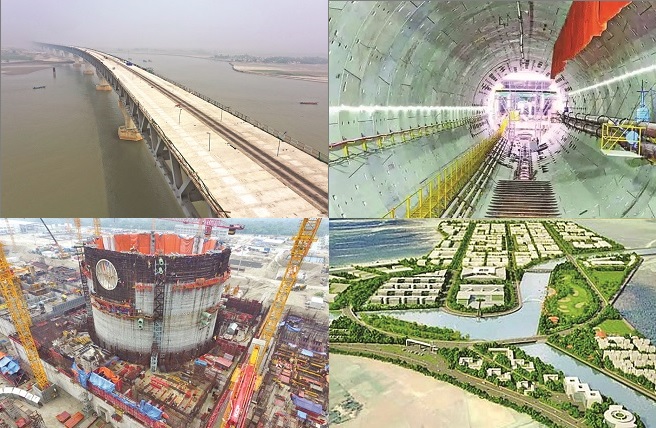Shamim Jahangir, Hasibul Aman
Published:2021-10-24 15:11:10 BdST
Bangladesh becoming a higher mid-income country
Driven by economic and social sector success in the last decade, Bangladesh has been one of the world’s most resilient economies and is projected to grow further to become a higher middle-income nation in the next decade.
Enviable success in poverty reduction, increased participation of women in the labour force and a thriving manufacturing sector have set Bangladesh on a high-growth track, which is expected to eventually turn the country into a well-off nation shortly, according to economic analysts.
The planned economic zones, large infrastructure projects, rise in investment, skilled manpower, diversified export basket and strong remittance inflow are also going to support the country’s journey towards becoming a higher mid-income country.
Even, Bangladesh has surpassed India in terms of per capita income as the figure stood at $2,227 in FY21, $280m higher than India's $1,947.
“Bangladesh has a very good economic prospect, given its recent success in reducing poverty, ensuring greater women participation in the labour force and expanding manufacturing sector,” Dr Binayak Sen, Director General, Bangladesh Institute of Development Studies (BIDS) said on Saturday.
“Women participation in the workforce increased to 36 percent in Bangladesh now since 1990, while the rate declined to 20 percent in India since 2010,” he said, adding that the manufacturing sector’s contribution to GDP soared to 20 percent from 10 percent in two decades, but the contribution in India slipped from 17 percent to 13 percent.
The country has been recommended by the UN for graduating from Least Developed Country (LDC) group in 2026 which is expected to raise its status across the globe.
The Citi Group has listed Bangladesh as one of the 11 most growth prospective countries until 2050. The JP Morgan has labelled Bangladesh as one of the "Frontier Five" economies with high potential to become an attractive destination for investment as well.
Besides, according to the latest report of the Pricewaterhouse Coopers, Bangladesh will become the 23rd largest economy in the world by 2050 which is now at 38th position.
The service sector accounts for 52 percent of GDP, the industrial sector 33 percent and agriculture 14.2 percent.
Bangladesh is a major agricultural producer, particularly in the production of rice (4th), fisheries (3rd), jute (2nd), tea (10th) and tropical fruits (5th).
Major industries include textiles, pharmaceuticals, shipbuilding, steel, electronics, telecommunications, energy, fertilizer, cement, leather, food processing and ceramics.
Bangladesh has sustained a GDP growth rate above 6 percent over the last decade.
Bangladesh recently adopted a second perspective plan which aims to bring down the extreme poverty rate to 2.55 percent, and increase the GDP growth to 9 percent by 2031.
It comes as part of the government's move to achieve a middle-income country status by 2031 and a higher income and developed country by 2041.
The plan eyes to cut extreme poverty rate further to 0.68 percent and push up GDP growth further to 9.9 percent by 2041.
“The document is framed and approved to alleviate poverty, strengthen good governance further and transform Bangladesh into a modern and world-standard digital country,” Planning Minister MA Mannan said.
According to the second perspective plan, the country’s per capita income at the current price would stand at $12,500 by 2041.
In addition, the moderate poverty rate is projected to come down to 7 percent in 2031 and to 3 percent in 2041.
To take the advantage of demographic dividends and develop human resources through quality education, the government in the plan set the target to provide free education for all aged up to 12 years, 100 percent literacy, low-cost health insurance and treatment facilities for all.
The government has set a target to set up 100 economic zones across the country as a tool for the country’s economic transformation with increased investments both from home and abroad.
“Even 20 to 30 economic zones can set up within a decade, the country’s investment level will rise to 40 percent of GDP from the current 29-30 percent rate. It will help Bangladesh a lot in becoming a higher middle-income country,” Dr Binayak Sen said.
However, he suggested remaining cautious about the wastage of public money in infrastructure projects; otherwise, the country has to suffer from it.
Unauthorized use or reproduction of The Finance Today content for commercial purposes is strictly prohibited.


